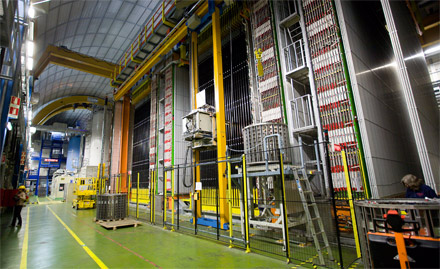 The science and even the popular press are filled with excitement at the moment after the OPERA experiment at Europe’s giant particle physics laboratory, CERN (to which I applied for a summer job when I was 16, but that’s another story). Apparently, neutrinos sent from CERN and captured at Italy’s INFN Gran Sasso Laboratory about 730 km away are arriving faster than scientists thought physically possible – faster than the speed of light travelling in a vacuum.
The science and even the popular press are filled with excitement at the moment after the OPERA experiment at Europe’s giant particle physics laboratory, CERN (to which I applied for a summer job when I was 16, but that’s another story). Apparently, neutrinos sent from CERN and captured at Italy’s INFN Gran Sasso Laboratory about 730 km away are arriving faster than scientists thought physically possible – faster than the speed of light travelling in a vacuum.
 I had to write about this because the news reporting has really annoyed me. Every announcement has said that Einstein might be wrong because he (special relativity) says nothing can travel faster than light in a vacuum. Poppycock! (As I’m being polite.) What the theory says is that nothing that has what scientists call “rest mass” can travel at the speed of light – there isn’t any block on things travelling faster. It’s always slightly surprised me that in a discipline where mathematical physicists are used to things called discontinuous functions, I rarely hear of people willing to accept that something could go from “slower” to “faster” without having to “equal”, but it might be possible.
I had to write about this because the news reporting has really annoyed me. Every announcement has said that Einstein might be wrong because he (special relativity) says nothing can travel faster than light in a vacuum. Poppycock! (As I’m being polite.) What the theory says is that nothing that has what scientists call “rest mass” can travel at the speed of light – there isn’t any block on things travelling faster. It’s always slightly surprised me that in a discipline where mathematical physicists are used to things called discontinuous functions, I rarely hear of people willing to accept that something could go from “slower” to “faster” without having to “equal”, but it might be possible.
One argument against travelling faster than light is that, although there are solutions to Einstein’s equations, they contain the square root of minus one which we sometimes call an “imaginary” number (as opposed to other numbers that are called “real”). This is a brilliant example of mathematical spin and how it has actually damaged our understanding of mathematics and the universe. There is nothing less real about these imaginary numbers than what are called the real ones. It’s actually by combining both set that we achieve a far deeper understanding of the mathematical and physical universe. But way back when they were first introduced, French mathematician and philosopher Rene Decartes was very distrustful of them so coined the term imaginary as a pejorative description, hoping it would mean they didn’t catch on. He’s got a lot to answer for.
What is a neutrino? Like the similarly named neutron, a neutrino carries no net electric charge (compared with other familiar subatomic particles such as electrons (-1) or protons (+1). Unlike the neutron, the neutrino has almost (but not quite) no mass. Having no charge and almost no mass makes a neutrino extremely difficult to detect.
Back to relativity! Anything travelling faster than light in relativity yields solutions including the square root of minus one which people have interpreted as meaning travelling backwards in time. That’s the reason for the joke that’s currently doing the rounds on the twittersphere:
Barman: “I’m sorry, sir. We don’t serve neutrinos in here.”
A neutrino walks into a bar.



